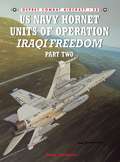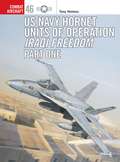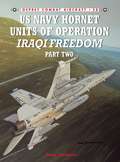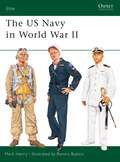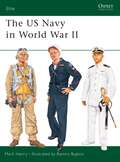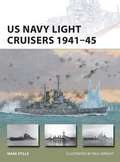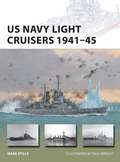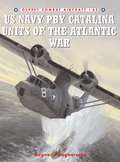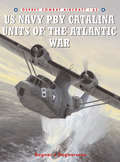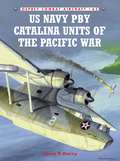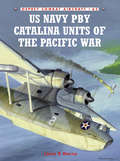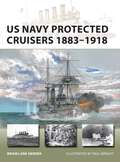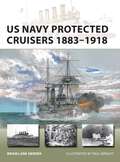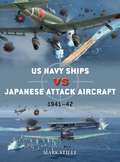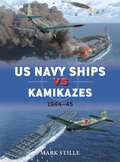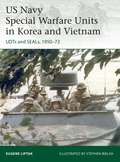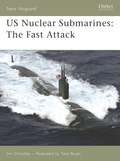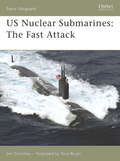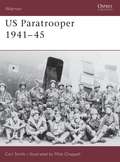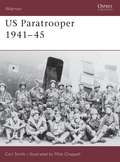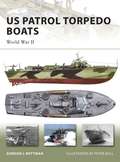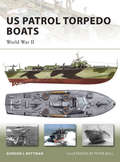- Table View
- List View
US Navy Hornet Units of Operation Iraqi Freedom (Combat Aircraft)
by Tony Holmes Chris DaveyThis book explores the role of the US Navy Hornet units in the northern Iraqi campaign. These units were the first Navy Reserve unit to be mobilized since the Korean War, and their attacks were launched from carriers off the coast of Turkey. The conflict for these squadrons was very different from the campaign fought in southern Iraq: they worked almost exclusively with clandestine Special Forces teams from the US Army, Marine Corps, Navy SEALs, British and Australian SAS and Kurdish guerrillas. First-hand accounts accompany the indispensable role these units had in the battle to liberate Iraq.
US Navy Hornet Units of Operation Iraqi Freedom (Combat Aircraft #46)
by Tony Holmes Chris DaveyThe F/A-18 Hornet in its various guises was the 'universal soldier' of OIF, with around 250 seeing combat. Flown by various squadrons and groups, the Hornet attacked a range of targets including tanks of the various Iraqi Republican Guard units and government buildings housing elements of the Baath party regime. Apart from its ability to drop precision munitions such as laser-guided bombs, the Hornet was also capable of launching anti-radar missiles and acting as an aerial tanker and reconnaissance platform for other strike types. This book explores the Hornet's versatility which has enhanced its reputation as one of the world's leading strike-fighter aircraft.
US Navy Hornet Units of Operation Iraqi Freedom (Combat Aircraft #58)
by Tony Holmes Chris DaveyThis book explores the role of the US Navy Hornet units in the northern Iraqi campaign. These units were the first Navy Reserve unit to be mobilized since the Korean War, and their attacks were launched from carriers off the coast of Turkey. The conflict for these squadrons was very different from the campaign fought in southern Iraq: they worked almost exclusively with clandestine Special Forces teams from the US Army, Marine Corps, Navy SEALs, British and Australian SAS and Kurdish guerrillas. First-hand accounts accompany the indispensable role these units had in the battle to liberate Iraq.
The US Navy in World War II (Elite)
by Ramiro Bujeiro Mark HenryIn 1941 the US Navy had 17 battleships of which eight would be knocked out on the first day of the war four aircraft carriers, and about 340,000 men including reservists. Pearl Harbor so weakened it that it was unable to prevent the Japanese capture of the Philippines and a vast sweep of Pacific islands. By 1945 it was the strongest navy the world had ever seen, with nearly 100 carriers, 41,000 aircraft and 3.3 million men; the unrivalled master of air-sea and amphibious operations, it was poised to invade Japan's home islands after reducing her fleet to scrap and her Pacific empire to impotence and starvation. This extraordinary story is illustrated here with dramatic photos, and nine meticulous colour plates showing a wide range of USN uniforms.
The US Navy in World War II (Elite #80)
by Mark HenryIn 1941 the US Navy had 17 battleships of which eight would be knocked out on the first day of the war four aircraft carriers, and about 340,000 men including reservists. Pearl Harbor so weakened it that it was unable to prevent the Japanese capture of the Philippines and a vast sweep of Pacific islands. By 1945 it was the strongest navy the world had ever seen, with nearly 100 carriers, 41,000 aircraft and 3.3 million men; the unrivalled master of air-sea and amphibious operations, it was poised to invade Japan's home islands after reducing her fleet to scrap and her Pacific empire to impotence and starvation. This extraordinary story is illustrated here with dramatic photos, and nine meticulous colour plates showing a wide range of USN uniforms.
US Navy Light Cruisers 1941–45 (New Vanguard #236)
by Mark Stille Mr Paul WrightDuring World War II, the United States built 72 light cruisers of various classes. In response to the severe air threat that surface ships faced, new cruisers were designed with increasingly heavy antiaircraft weaponry as well as the traditional 6in guns. With the speed and range to keep up with aircraft carriers, and their considerable antiaircraft capability, they were a mainstay of the carrier escorts.This book examines every US light cruiser produced, including those of the Fargo and Worcester classes, which were actually complete after World War II had ended, tracing their design, development and evolution throughout the war and beyond.
US Navy Light Cruisers 1941–45 (New Vanguard)
by Paul Wright Mark StilleDuring World War II, the United States built 72 light cruisers of various classes. In response to the severe air threat that surface ships faced, new cruisers were designed with increasingly heavy antiaircraft weaponry as well as the traditional 6in guns. With the speed and range to keep up with aircraft carriers, and their considerable antiaircraft capability, they were a mainstay of the carrier escorts.This book examines every US light cruiser produced, including those of the Fargo and Worcester classes, which were actually complete after World War II had ended, tracing their design, development and evolution throughout the war and beyond.
US Navy PBY Catalina Units of the Atlantic War (Combat Aircraft)
by Jim Laurier Ragnar J RagnarssonSeveral books have been written about US naval patrol aviation in World War 2, but none do full justice to the role played by patrol squadrons of the US Navy in the longest, most bitterly fought campaign of the war the Battle of the Atlantic. From the Arctic to the Equator, anti-submarine aircraft of the US Navy patrolled both sides of the stormy Atlantic alongside their allied counterparts, escorting merchant shipping through submarine-infested waters the crucial lifeline from the United States to Great Britain and the Mediterranean, and staging troops and supplies for the ultimate liberation of North Africa and Europe. This book details the PBY Catalina, without contest the most successful flying boat ever designed, and a key element in the success of the Atlantic War.
US Navy PBY Catalina Units of the Atlantic War (Combat Aircraft #65)
by Jim Laurier Ragnar J RagnarssonSeveral books have been written about US naval patrol aviation in World War 2, but none do full justice to the role played by patrol squadrons of the US Navy in the longest, most bitterly fought campaign of the war the Battle of the Atlantic. From the Arctic to the Equator, anti-submarine aircraft of the US Navy patrolled both sides of the stormy Atlantic alongside their allied counterparts, escorting merchant shipping through submarine-infested waters the crucial lifeline from the United States to Great Britain and the Mediterranean, and staging troops and supplies for the ultimate liberation of North Africa and Europe. This book details the PBY Catalina, without contest the most successful flying boat ever designed, and a key element in the success of the Atlantic War.
US Navy PBY Catalina Units of the Pacific War (Combat Aircraft)
by Jim Laurier Louis B DornyDeadly in its primary role as a submarine hunter, the PBY Catalina was the scourge of the Imperial Japanese Navy's submarine force. Its amphibious traits also made the aircraft well suited to air-sea rescue, and thousands of Allied airmen were saved from a watery grave by PBY crews. Using personal interviews, war diaries and combat reports combined with original Japanese records and books, Louis B Dorny provides a view on the role of the Catalina from both side of the war. Illustrated with over 80 photographs and colour profiles detailing aircraft markings, this is the definitive history of an insight into the PBY's use by the US Navy and Allied forces in the Pacific during World War 2.
US Navy PBY Catalina Units of the Pacific War (Combat Aircraft #62)
by Jim Laurier Louis B DornyDeadly in its primary role as a submarine hunter, the PBY Catalina was the scourge of the Imperial Japanese Navy's submarine force. Its amphibious traits also made the aircraft well suited to air-sea rescue, and thousands of Allied airmen were saved from a watery grave by PBY crews. Using personal interviews, war diaries and combat reports combined with original Japanese records and books, Louis B Dorny provides a view on the role of the Catalina from both side of the war. Illustrated with over 80 photographs and colour profiles detailing aircraft markings, this is the definitive history of an insight into the PBY's use by the US Navy and Allied forces in the Pacific during World War 2.
US Navy Protected Cruisers 1883–1918 (New Vanguard #320)
by Brian Lane HerderExplores the history of the US Navy's 11 new steel warships, built during the late 19th century to advance American naval supremacy.After the American Civil War, the powerful US Navy was allowed to decay into utter decrepitude, and was becoming a security liability. In 1883, Congress approved four new steel-constructed vessels called the “ABCD” ships. The three protected cruisers Atlanta, Boston, and Chicago were the first steel warships built for the US Navy, whose 1880s–1890s technological and cultural transformation was so total it is now remembered as the “New Navy”. This small fleet was joined by a succession of new and distinctive protected cruisers, culminating in the famous and powerful Olympia. These 11 protected cruisers formed the backbone of the early US steel navy, and were in the frontline of the US victory in the 1898 Spanish-American War. It was these warships that fought and won the decisive Battle of Manila Bay. These cruisers also served faithfully as escorts and auxiliaries in World War I before the last were retired in the 1920s.Written by experienced US naval researcher Brian Lane Herder, and including rare photographs, this book explores the development, qualities, and service of these important warships, and highlights the almost-forgotten Columbia-class, designed as high-speed commerce raiders, and to mimic specific passenger liners. All 11 protected cruisers are depicted in meticulously researched color illustrations with one depicting the Olympia deploying her full sail rig.
US Navy Protected Cruisers 1883–1918 (New Vanguard #320)
by Brian Lane HerderExplores the history of the US Navy's 11 new steel warships, built during the late 19th century to advance American naval supremacy.After the American Civil War, the powerful US Navy was allowed to decay into utter decrepitude, and was becoming a security liability. In 1883, Congress approved four new steel-constructed vessels called the “ABCD” ships. The three protected cruisers Atlanta, Boston, and Chicago were the first steel warships built for the US Navy, whose 1880s–1890s technological and cultural transformation was so total it is now remembered as the “New Navy”. This small fleet was joined by a succession of new and distinctive protected cruisers, culminating in the famous and powerful Olympia. These 11 protected cruisers formed the backbone of the early US steel navy, and were in the frontline of the US victory in the 1898 Spanish-American War. It was these warships that fought and won the decisive Battle of Manila Bay. These cruisers also served faithfully as escorts and auxiliaries in World War I before the last were retired in the 1920s.Written by experienced US naval researcher Brian Lane Herder, and including rare photographs, this book explores the development, qualities, and service of these important warships, and highlights the almost-forgotten Columbia-class, designed as high-speed commerce raiders, and to mimic specific passenger liners. All 11 protected cruisers are depicted in meticulously researched color illustrations with one depicting the Olympia deploying her full sail rig.
US Navy Ships vs Japanese Attack Aircraft: 1941–42 (Duel)
by Mark StilleThe striking power of the Imperial Japanese Navy's carrier-based attack aircraft was established at Pearl Harbor, and the IJN's carrier-based torpedo and dive-bombers showed their prowess again at the Battle of Coral Sea when they sank the US Navy carrier USS Lexington and damaged the carrier USS Yorktown. Even at the disastrous Battle of Midway, the relatively small number of IJNAF attack- and torpedo-bombers that were launched against the US fleet proved that they remained a potent force by heavily damaging Yorktown again, which allowed an IJN submarine to sink the carrier. At Guadalcanal, IJNAF carrier-based aircraft sank the carrier USS Hornet and badly damaged USS Enterprise twice. However, throughout 1942, US Navy ship defences brought down an increasing number of attacking IJNAF aircraft. The final major battle of the year, the Battle of Santa Cruz, exacted crippling losses on the IJN, setting the stage for the eclipse of the IJNAF's highly trained and effective aviation attack forces. Packed with illustrations and contemporary photographs, this engrossing volume details the design, tactics, and operational records of both the US Navy ships and the IJNAF aircraft which attacked them over the year following Pearl Harbor.
US Navy Ships vs Japanese Attack Aircraft: 1941–42 (Duel #105)
by Mark StilleThe striking power of the Imperial Japanese Navy's carrier-based attack aircraft was established at Pearl Harbor, and the IJN's carrier-based torpedo and dive-bombers showed their prowess again at the Battle of Coral Sea when they sank the US Navy carrier USS Lexington and damaged the carrier USS Yorktown. Even at the disastrous Battle of Midway, the relatively small number of IJNAF attack- and torpedo-bombers that were launched against the US fleet proved that they remained a potent force by heavily damaging Yorktown again, which allowed an IJN submarine to sink the carrier. At Guadalcanal, IJNAF carrier-based aircraft sank the carrier USS Hornet and badly damaged USS Enterprise twice. However, throughout 1942, US Navy ship defences brought down an increasing number of attacking IJNAF aircraft. The final major battle of the year, the Battle of Santa Cruz, exacted crippling losses on the IJN, setting the stage for the eclipse of the IJNAF's highly trained and effective aviation attack forces. Packed with illustrations and contemporary photographs, this engrossing volume details the design, tactics, and operational records of both the US Navy ships and the IJNAF aircraft which attacked them over the year following Pearl Harbor.
US Navy Ships vs Kamikazes 1944–45 (Duel)
by Jim Laurier Mark StilleThe ineffectiveness of conventional air attacks on US Navy surface ships, particularly heavily defended targets like carrier task groups, forced the Japanese to re-evaluate their tactics in late 1944. The solution they arrived at was simple – crash their aircraft into American ships. This notion of self-sacrifice fit well within the Japanese warrior psyche and proved terrifying to the American sailors subjected to it. These tactics brought immediate results, and proved effective until the end of the war.This book examines this terrifying new way of waging war, revealing how the US Navy was forced to adapt its tactics and deploy new weapons to counter the threat posed by kamikaze attacks, as well as assessing whether the damage caused to American naval strength by the loss of so many pilots and aircraft actually had a material impact.
US Navy Ships vs Kamikazes 1944–45 (Duel #76)
by Mark StilleThe ineffectiveness of conventional air attacks on US Navy surface ships, particularly heavily defended targets like carrier task groups, forced the Japanese to re-evaluate their tactics in late 1944. The solution they arrived at was simple – crash their aircraft into American ships. This notion of self-sacrifice fit well within the Japanese warrior psyche and proved terrifying to the American sailors subjected to it. These tactics brought immediate results, and proved effective until the end of the war.This book examines this terrifying new way of waging war, revealing how the US Navy was forced to adapt its tactics and deploy new weapons to counter the threat posed by kamikaze attacks, as well as assessing whether the damage caused to American naval strength by the loss of so many pilots and aircraft actually had a material impact.
US Navy Special Warfare Units in Korea and Vietnam: UDTs and SEALs, 1950–73 (Elite)
by Eugene LiptakDuring the Korean War and the Vietnam War, US Navy Special Warfare units played a variety of vital combat roles amid two of the deadliest conflicts of the Cold War. In Korea, underwater demolition teams (UDTs) surveyed beaches for amphibious operations, cleared sea mines from harbors, conducted seaborne raids against inshore targets, and served as scouts for the infiltration of Korean guerrillas and British Royal Marine Commando raids along the North Korean coast. In South Vietnam, UDTs surveyed beaches and demolished Viet Cong bunkers, supply caches, and river obstacles in the Mekong Delta. The SEALs (Sea Air Land teams) deployed entire platoons into the Mekong Delta and the Rung Sat Special Zone to conduct guerrilla warfare against the Viet Cong that included ambushes, reconnaissance, and capturing leaders and supply caches. In addition, the SEALs also played important roles in the Phoenix Program and in rescuing prisoners of war. Fully illustrated throughout, this study explores how the US Navy's specially trained naval commandos accomplished their missions in Korea and Vietnam.
US Navy Special Warfare Units in Korea and Vietnam: UDTs and SEALs, 1950–73 (Elite)
by Eugene LiptakDuring the Korean War and the Vietnam War, US Navy Special Warfare units played a variety of vital combat roles amid two of the deadliest conflicts of the Cold War. In Korea, underwater demolition teams (UDTs) surveyed beaches for amphibious operations, cleared sea mines from harbors, conducted seaborne raids against inshore targets, and served as scouts for the infiltration of Korean guerrillas and British Royal Marine Commando raids along the North Korean coast. In South Vietnam, UDTs surveyed beaches and demolished Viet Cong bunkers, supply caches, and river obstacles in the Mekong Delta. The SEALs (Sea Air Land teams) deployed entire platoons into the Mekong Delta and the Rung Sat Special Zone to conduct guerrilla warfare against the Viet Cong that included ambushes, reconnaissance, and capturing leaders and supply caches. In addition, the SEALs also played important roles in the Phoenix Program and in rescuing prisoners of war. Fully illustrated throughout, this study explores how the US Navy's specially trained naval commandos accomplished their missions in Korea and Vietnam.
US Nuclear Submarines: The Fast Attack (New Vanguard)
by Tony Bryan Jim ChristleyThe adoption of nuclear power revolutionized submarine design and means that vessels can stay underwater for months, trailing the enemy or training weapons on land targets from secret positions, "always there, never seen.†? Jim Christley, a former submariner, explores here the influence of Admiral Hyman Rickover in cautiously introducing these stealthy machines of war, and frankly discusses the power and perils of using nuclear reactors at sea. Using unique and detailed artwork, he outlines the many evolving aspects of design within the submarine classes, from the very first nuclear submarine, USS Nautilus, to the classes under construction even now.
US Nuclear Submarines: The Fast Attack (New Vanguard #138)
by Tony Bryan Jim ChristleyThe adoption of nuclear power revolutionized submarine design and means that vessels can stay underwater for months, trailing the enemy or training weapons on land targets from secret positions, "always there, never seen.†? Jim Christley, a former submariner, explores here the influence of Admiral Hyman Rickover in cautiously introducing these stealthy machines of war, and frankly discusses the power and perils of using nuclear reactors at sea. Using unique and detailed artwork, he outlines the many evolving aspects of design within the submarine classes, from the very first nuclear submarine, USS Nautilus, to the classes under construction even now.
US Paratrooper 1941–45 (Warrior #26)
by Carl Smith Mike ChappellIn Sicily, Normandy, and in the frozen hills of the Ardennes, America's airborne warriors proved themselves some of the toughest and most determined soldiers of World War 2. What made these soldiers so special? How were they recruited, how did they learn to jump and fight? What special tactics and equipment did they use? This title looks at what it was like to be one of the United States' airborne elite, through the experiences of the soldiers themselves. It is the story of the men who invariably led the way; the soldiers who flew to battle and walked home.
US Paratrooper 1941–45 (Warrior #26)
by Carl Smith Mike ChappellIn Sicily, Normandy, and in the frozen hills of the Ardennes, America's airborne warriors proved themselves some of the toughest and most determined soldiers of World War 2. What made these soldiers so special? How were they recruited, how did they learn to jump and fight? What special tactics and equipment did they use? This title looks at what it was like to be one of the United States' airborne elite, through the experiences of the soldiers themselves. It is the story of the men who invariably led the way; the soldiers who flew to battle and walked home.
US Patrol Torpedo Boats: World War II (New Vanguard)
by Peter Bull Gordon L. RottmanMotor torpedo boat development began in the early 1900s, and the vessels first saw service during World War I. However, it was not until the late 1930s that the US Navy commenced the development of the Patrol Torpedo or PT boat. The PT boat was designed for attacking larger warships with torpedoes using its 'stealth' ability, high-speed and small size to launch and survive these attacks – although they were employed in a wide variety of other missions, including rescuing General MacArthur and his entourage from the Philippines. This book examines the design and development of these unique craft, very few of which survive today, and goes on to examine their role and combat deployment in World War II.
US Patrol Torpedo Boats: World War II (New Vanguard #148)
by Gordon L. RottmanALSO AVAILABLE AS AN E-BOOK. Motor torpedo boat development began in the early 1900s, and the vessels first saw service during World War I. However, it was not until the late 1930s that the US Navy commenced the development of the Patrol Torpedo or PT boat. The PT boat was designed for attacking larger warships with torpedoes using its 'stealth' ability, high-speed and small size to launch and survive these attacks – although they were employed in a wide variety of other missions, including rescuing General MacArthur and his entourage from the Philippines. This book examines the design and development of these unique craft, very few of which survive today, and goes on to examine their role and combat deployment in World War II.
